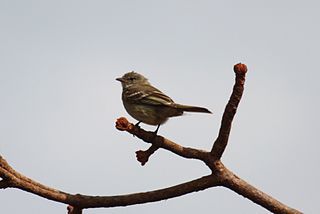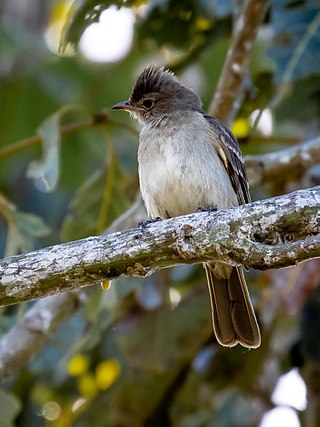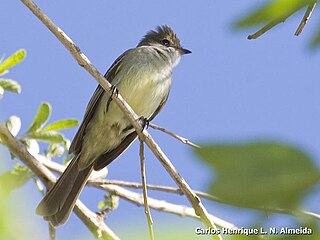
The mountain elaenia is a small passerine bird in subfamily Elaeniinae of family Tyrannidae, the tyrant flycatchers. It is found in Colombia, Costa Rica, El Salvador, Guatemala, Honduras, Nicaragua, Panama, and Venezuela.

The white-crested elaenia is a species of bird in subfamily Elaeniinae of family Tyrannidae, the tyrant flycatchers. It is found in Bolivia, Chile, Colombia, Ecuador, and Peru.

The lesser elaenia is a species of bird in subfamily Elaeniinae of family Tyrannidae, the tyrant flycatchers. It is found in Costa Rica, Panama, on Trinidad, in every mainland South American country except Chile and Uruguay, and as a vagrant on Bonaire and Curaçao.

The plain-crested elaenia is a species of bird in subfamily Elaeniinae of family Tyrannidae, the tyrant flycatchers. It is found in Bolivia, Brazil, Colombia, French Guiana, Guyana, Peru, Suriname, and Venezuela.

The great elaenia is a species of bird in subfamily Elaeniinae of family Tyrannidae, the tyrant flycatchers. It is found in Brazil and Venezuela.

The Greater Antillean elaenia is a species of bird in subfamily Elaeniinae of family Tyrannidae, the tyrant flycatchers. It is found in the Dominican Republic, Haiti, and Jamaica.

The mottle-backed elaenia is a species of bird in subfamily Elaeniinae of family Tyrannidae, the tyrant flycatchers. It is found in Bolivia, Colombia, Ecuador, and Peru.

The Caribbean elaenia is a species of bird in subfamily Elaeniinae of family Tyrannidae, the tyrant flycatchers. It is found in the West Indies, in parts of Central America, and on islands just off the northern South American coast.

The highland elaenia is a species of bird in subfamily Elaeniinae of family Tyrannidae, the tyrant flycatchers. It is found in Argentina, Bolivia, Ecuador, and Peru.

The sierran elaenia is a species of bird in subfamily Elaeniinae of family Tyrannidae, the tyrant flycatchers. It is found in Bolivia, Colombia, Ecuador, and Peru.

The small-billed elaenia is a species of bird in subfamily Elaeniinae of family Tyrannidae, the tyrant flycatchers. It is found in every mainland South American country except Chile, plus Aruba and Trinidad.

The brownish elaenia is a species of bird in subfamily Elaeniinae of family Tyrannidae, the tyrant flycatchers. It is found in Bolivia, Brazil, Peru, and possibly Colombia.

The rufous-crowned elaenia is a species of bird in subfamily Elaeniinae of family Tyrannidae, the tyrant flycatchers. It is found in Brazil, Colombia, French Guiana, Guyana, Suriname, and Venezuela.

The large elaenia is a species of bird in subfamily Elaeniinae of family Tyrannidae, the tyrant flycatchers. It is found in Argentina, Bolivia, Brazil, Colombia, Ecuador, Paraguay, Peru, and Uruguay.

The yellow-crowned elaenia is a species of bird in subfamily Elaeniinae of family Tyrannidae, the tyrant flycatchers. It is found in Brazil, Colombia, Ecuador, French Guiana, Guyana, Peru, Suriname, and Venezuela.

The northern scrub flycatcher is a species of bird in the family Tyrannidae, the tyrant flycatchers. It is found in Aruba, Bonaire, Colombia, Costa Rica, Curaçao, French Guiana, Guyana, Panama, Suriname, Trinidad, and Venezuela.

The Peruvian tyrannulet is a species of bird in the family Tyrannidae, the tyrant flycatchers. It is endemic to Peru.

The small-headed elaenia, also known as the Brazilian elaenia, is a species of bird in subfamily Elaeniinae of family Tyrannidae, the tyrant flycatchers. It is found in Argentina, Brazil, Paraguay, and Uruguay.

The Chilean elaenia is a species of bird in subfamily Elaeniinae of family Tyrannidae, the tyrant flycatchers. It is found in Argentina, Bolivia, Brazil, Chile, Colombia, Paraguay, Peru, and Uruguay.

The tepui elaenia is a species of bird in subfamily Elaeniinae of family Tyrannidae, the tyrant flycatchers. It is found in Brazil, Guyana, and Venezuela.























